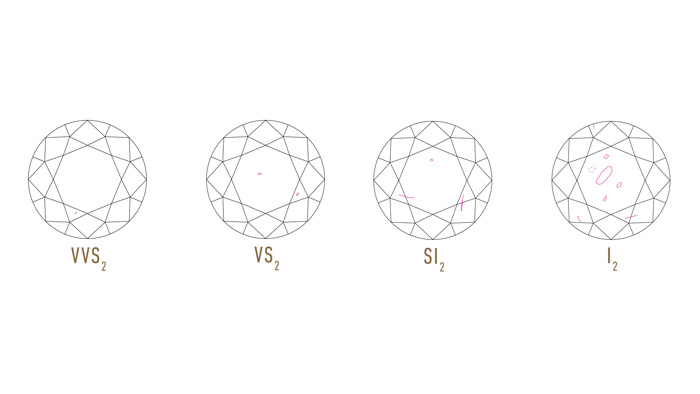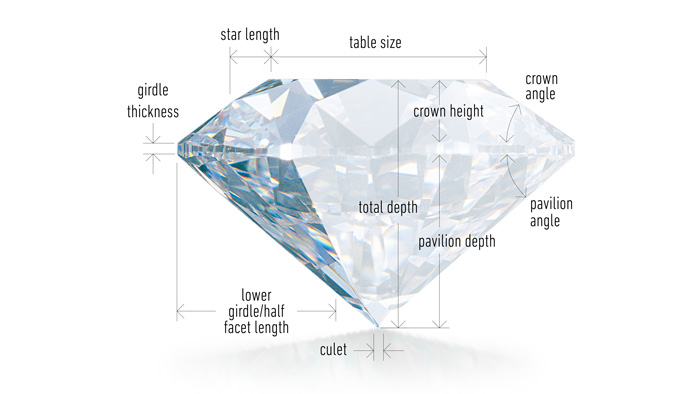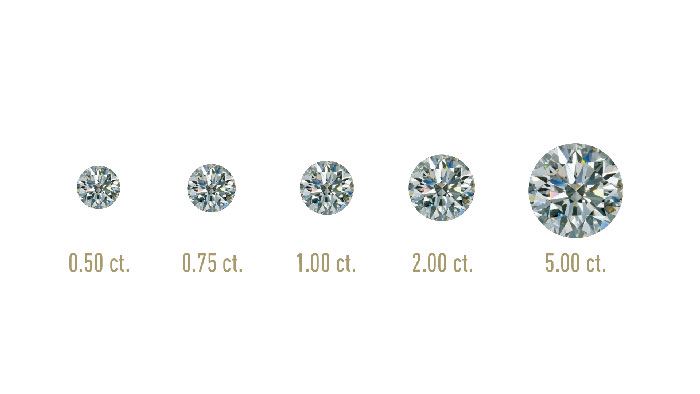The 4 C’s of a Diamond
The Gemological Institure of America created the first, and now globally accepted standard for describing diamonds: Color, Clarity, Cut and Carat Weight. Today, the 4Cs of Diamond Quality is the universal method for assessing the quality of any diamond, anywhere in the world. The creation of the Diamond 4Cs meant two very important things: diamond quality could be communicated in a universal language, and diamond customers could now know exactly what they were about to purchase.

COLOUR
Diamond colour is based on the absence of any colour in the stone. A structurally perfect diamond has no hue and therefore a higher value. We measure the colour in a diamond via an alphabetical system that starts at D (being the whitest of white) and ends at Z (there is very little distincton between a Z colour diamond and a fancy light yellow with the latter being considerably more expernsive due to its grading.) Many of these diamond colour distinctions are so subtle that they are invisible to the untrained eye; however, these distinctions make a very big difference in diamond quality and more importantly price.
SB Tip: Look at the stones in front of you and choose the one you love rather than buying a stone from the paperwork that comes with it. You can go as low as a K on a GIA certfied stone before any noticeable colour is present however with a less strict certifying body such as EGL or HRD perhaps an H. Some of my favourite rings we have made contain lower colour higher clarity diamonds.

CLARITY
Diamond clarity refers to the absence of inclusions and blemishes. Natural diamonds are the result of carbon exposed to tremendous heat and pressure deep in the earth. This process can result in a variety of characteristics called ‘inclusions’ and ‘blemishes.’ While no diamond is perfectly pure, the closer it comes, the higher its value.
The GIA Diamond Clarity Scale has 6 categories:
- Flawless (FL) No inclusions and no blemishes visible under 10x magnification
- Internally Flawless (IF) No inclusions visible under 10x magnification
- Very, Very Slightly Included (VVS1 and VVS2) Inclusions so slight they are difficult for a skilled grader to see under 10x magnification
- Very Slightly Included (VS1 and VS2) Inclusions are observed with effort under 10x magnification, but can be characterized as minor
- Slightly Included (SI1 and SI2) Inclusions are noticeable under 10x magnification
- Included (I1, I2, and I3) Inclusions are obvious under 10x magnification which may affect transparency and brilliance
SB Tip: Bear in mind that very few people can see most of the above flaws to the naked eye probably an SI and below. Whilst it is obviously more desirable to have a cleaner stone, I believe a brilliant compromise in order to maximise the size of your stone is to go for a diamond that has flaws that are cleverly disguised by the facets of the stone rather than directly under its table.

CUT
Diamonds are renowned for their ability to transmit light and sparkle so intensely. We often think of a diamond’s cut as shape (round, heart, oval, marquise, pear), but a diamond’s cut grade is really about how well a diamond’s facets interact with light.
Precise artistry and workmanship are required to fashion a stone so its proportions, symmetry and polish deliver the magnificent return of light only possible in a diamond.
SB Tip: It is our job to ensure we show you diamonds that are well cut therefore we encourage our clients to think of cut as the shape of the stone.

CARAT
This is probably the most misubnderstood of the 4C’s as many people believe it refers to the size of the diamond however it actually refers to how much a diamond weighs. A metric “carat” is defined as 200 milligrams. Each carat is subdivided into 100 ‘points.’ This allows very precise measurements to the hundredth decimal place. A jeweler may describe the weight of a diamond below one carat by its ‘points’ alone. For instance, the jeweler may refer to a diamond that weighs 0.25 carats as a ‘twenty-five pointer.’ Diamond weights greater than one carat are expressed in carats and decimals. A 1.08 carat stone would be described as ‘one point oh eight carats.’
All else being equal, diamond price increases with diamond carat weight because larger diamonds are rarer and more desirable. However, two diamonds of equal carat weight can have very different values (and prices) depending on three other factors of the diamond 4Cs: Color, Clarity, and Cut.
SB Tip: If you want the biggest diamond for your budget mm’s are more important than ct. This can also save you a fair bit of money… for example, the difference in mm between a 0.90ct diamond and a 1.00ct diamond is negligable yet the price astronimical.

Although the above 4C’s are incredibly important as a guide for consumers when buying a diamond as aforementioned I encourage my clients to choose a stone that they love not because of the paperwork that accompanies it but because of its unique characteristics. Diamonds can be certified by a range of governing bodies not just the GIA, some others include EGL, HRD and IGI.
Diamonds can also be sold uncertified; this by no means signifies that the stones are illegitimately sourced. Instead they are sold in packets of multiples stones with an approximate grade by the dealer pre certification rather than a definite grade. We sell alot of these (inc. antique diamonds) for SB rings as they quite often result in good “bang for buck”.


















